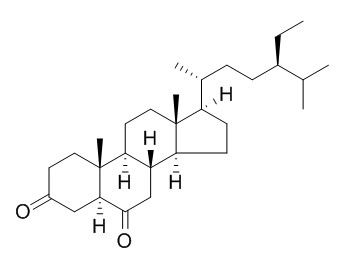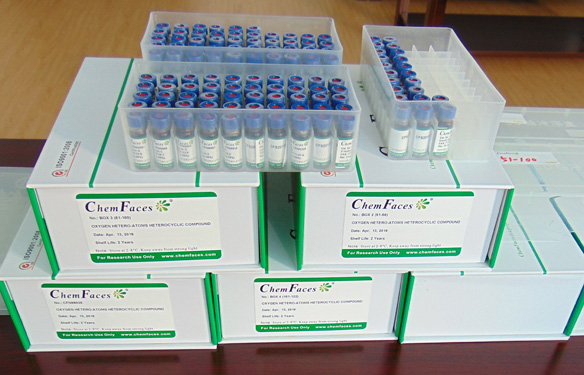Stigmastane-3,6-dione
Stigmastane-3,6-dione has anti-inflammatory activity. 5 alpha-Stigmastane-3,6-dione shows antifeedant activity against bell weevils.
Inquire / Order:
manager@chemfaces.com
Technical Inquiries:
service@chemfaces.com
Tel:
+86-27-84237783
Fax:
+86-27-84254680
Address:
1 Building, No. 83, CheCheng Rd., Wuhan Economic and Technological Development Zone, Wuhan, Hubei 430056, PRC
Providing storage is as stated on the product vial and the vial is kept tightly sealed, the product can be stored for up to
24 months(2-8C).
Wherever possible, you should prepare and use solutions on the same day. However, if you need to make up stock solutions in advance, we recommend that you store the solution as aliquots in tightly sealed vials at -20C. Generally, these will be useable for up to two weeks. Before use, and prior to opening the vial we recommend that you allow your product to equilibrate to room temperature for at least 1 hour.
Need more advice on solubility, usage and handling? Please email to: service@chemfaces.com
The packaging of the product may have turned upside down during transportation, resulting in the natural compounds adhering to the neck or cap of the vial. take the vial out of its packaging and gently shake to let the compounds fall to the bottom of the vial. for liquid products, centrifuge at 200-500 RPM to gather the liquid at the bottom of the vial. try to avoid loss or contamination during handling.
Asian Pac J Cancer Prev.2019, 20(1):65-72
Phytomedicine Plus2024, 4(4): 100655.
Appl. Sci.2020, 10(16),5482.
Kyung Hee University2024, rs-3888374
Food Sci Nutr.2023, 11(9):5532-5542.
Biomed Pharmacother.2021, 137:111362.
Int Immunopharmacol.2023, 123:110572.
Toxins (Basel).2020, 12(4):210.
Food Addit Contam Part A Chem Anal Control Expo Risk Assess.2020, 37(9):1437-1448.
Molecules.2021, 26(3):695.
Related and Featured Products
Planta Med., 2008, 74(9):983-4.
Three anti-inflammatory stigmastane steroids from Alchornea floribunda leaves[Reference:
WebLink]
The anti-inflammatory activities of these compounds were evaluated using in vitro and in vivo animal models.
METHODS AND RESULTS:
The compounds, 1, 2 and 3 at 5mg/ear inhibited xylene – induced ear edema in mice, with edema inhibitions of 59.9, 51.5 and 51.54% respectively. At 20mg/kg (ip), all the compounds significantly (p<0.05) inhibited acute inflammation induced by subplanta injection of undiluted egg albumen in rats' paw. Compound 1 exhibited a higher anti-inflammatory effect (% edema inhibition=50. 0) than prednisolone (% edema inhibition=48.0) at 3h. 1 and 3 at concentrations of 50 and 100μg/ml significantly (p<0.05) stabilized heat-induced haemolysis of human erythrocytes in vitro, but have no effect on hypotonicity-induced haemolysis. Spectral analysis elucidated the compounds as Stigmastane-3,6-dione (1), stigmastane-22-ene-3,6-dione (2) and 3-hydroxystigmastane-22-ene (3).
CONCLUSIONS:
These compounds may, in part, account for the anti-inflammatory effect of Alchornea floribunda leaves.
J. Agric.Food Chem.,1994, 42(7):1561-2.
Boll weevil antifeedants from Eleocharis dulcis Trin.[Reference:
WebLink]
METHODS AND RESULTS:
Six compounds were isolated from the CH2Cl2 extract of eleocharis dulcis Trin. They are hexacosanoic acid, 5 alpha-Stigmastane-3,6-dione, beta-sitosterol, stigmasterol, betulin, and tricin.
CONCLUSIONS:
5 alpha-Stigmastane-3,6-dione, betulin, and tricin showed antifeedant activity against boll weevils.
Nat Prod Res. 2013 Aug;27(15):1404-7.
Triterpenoid profile of flower and leaf cuticular waxes of heather Calluna vulgaris.[Pubmed:
23148482]
METHODS AND RESULTS:
Analysis of the main triterpenoid profile of chloroform-soluble cuticular waxes of heather flowers and leaves by GC-MS revealed the following composition: four ketones - α-amyrenone, 4-epi-friedelin, friedelin and taraxerone and seven steroids - campesterol, cholesterol, sitostanol, sitosterol, stigmasterol, stigmasta-3,5-dien-7-one and Stigmastane-3,6-dione. Triterpenoids accounted for 20% and 65% by mass of flower and leaf waxes, respectively, which suggest that heather leaves represent a very promising source of these compounds.
CONCLUSIONS:
Ursolic acid was the principal triterpenoid in the cuticular wax of both organs, whereas among the neutral triterpenes, friedelin and uvaol were the most abundant in flowers and leaves, respectively.
This report provides the first thorough overview of the triterpenoid composition of cuticular waxes of heather.



